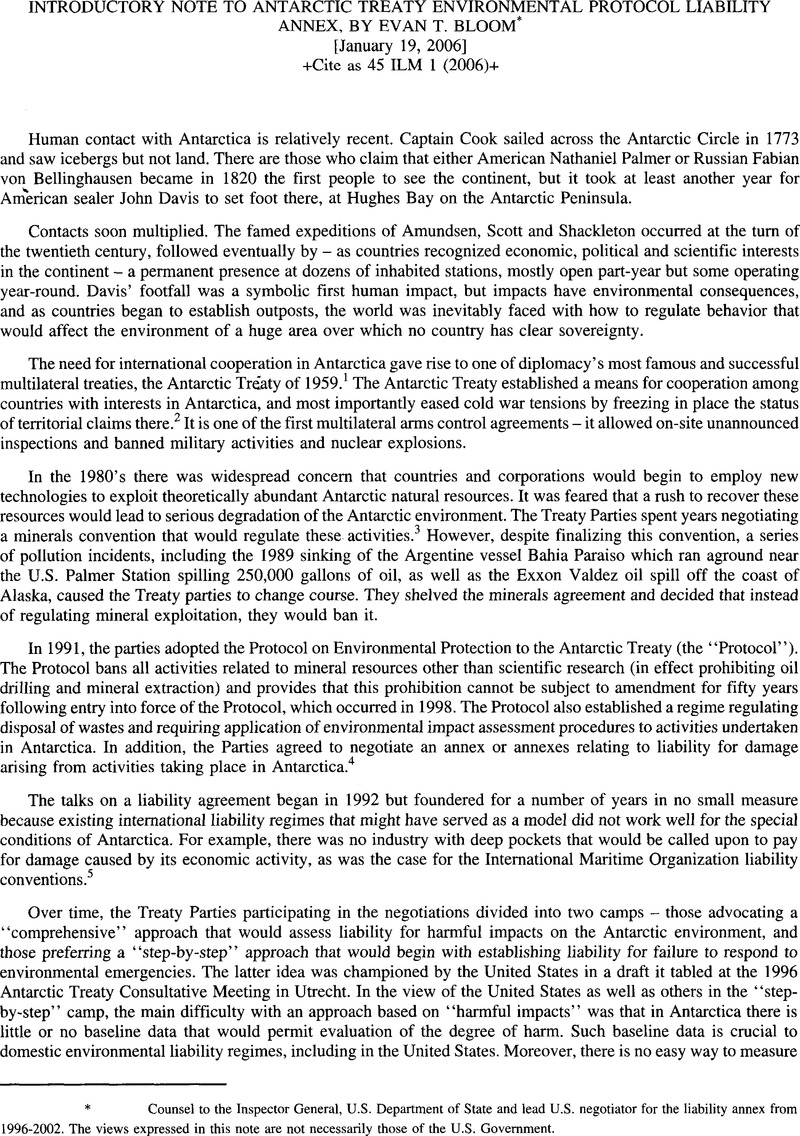Published online by Cambridge University Press: 27 February 2017

1 12 UST794, TIAS4780.
2 Seven countries claim sovereignty over Antarctic territory: Argentina, Australia, Chile, France, New Zealand, Norway, and the United Kingdom. The United States and Russia maintain a right to assert a future claim. Two additional treaties were negotiated for Antarctica and the Southern Ocean related to fishing and protection of seals. Convention on the Conservation of Antarctic Marine Living Resources, 33 UST 3476, TIAS 10240 (1980); Convention for the Conservation of Antarctic Seals, 29 UST 441, TIAS 8826 (1972).
3 Convention on the Regulation of Antarctic Mineral Resource Activities (1988). This convention has not been ratified by any state and did not enter into force.
4 ’ ‘Consistent with the objectives of this Protocol for the comprehensive protection of the Antarctic Environment and dependent and associated ecosystems, the Parties undertake to elaborate rules and procedures relating to liability for damage arising from activities taking place in the Antarctic Treaty area and covered by this Protocol. Those rules and procedures shall be included in one or more Annexes to be adopted in accordance with Article 9(2).” Environmental Protocol, Art. 16.
5 See, e.g., International Convention on Civil Liability for Oil Pollution Damage 973 U.N.T.S. 3 (1969); International Convention on Liability and Compensation for Damage in Connection with the Carriage of Hazardous and Noxious Substances by Sea (adopted 1996, not yet in force).
6 ” 1. In order to respond to environmental emergencies in the Antarctic Treaty area, each Party agrees to: (a) provide for prompt and effective response action to such emergencies which might arise in the performance of scientific research programmes, tourism and all other governmental and nongovernmental activities in the Antarctic Treaty area for which advance notice is required under Article VII (5) of the Antarctic Treaty, including associated logistic support activities; and (b) establish contingency plans for response to incidents with potential adverse effects on the Antarctic environment or dependent and associated ecosystems. 2. To this end, the Parties shall: (a) co-operate in the formulation and implementation of such contingency plans; and (b) establish procedures for immediate notification of, and co-operative response to, environmental emergencies. 3. In the implementation of this Article, the Parties shall draw upon the advice of the appropriate international organisations.” Environmental Protocol, Art. 15.
7 Antarctic Treaty, Art. VI.
8 During the negotiations there was some disagreement over whether fishing vessels are covered by the Article VII(5) notification requirements. Most Antarctic Treaty parties do not provide notification whether respect to fishing activities.
9 Liability Annex, Art. 6.
10 Liability Annex, Art. 2(c) and (d).
11 Liability Annex, Art. 6.
12 Liability Annex, Art. 2(b).
13 Liability Annex, Art. 2(f).
14 Liability Annex, Art. 7(4).
15 Liability Annex, Art. 7. Not all countries are party to the Antarctic Treaty and it was recognized that some non-State operators whose activities could give rise to liability might not be incorporated or have a principal place of business in a treaty Party. If that is the case, the Annex provides additional avenue for litigation by allowing suit to be brought in the courts of a Party which has regulatory authority over that operator as described in Art. 2(d).
16 The Annex tracks the language of Article 13(1) of the Protocol, which provides: “Each Party shall take appropriate measures within its competence, including the adoption of laws and regulations, administrative actions and enforcement measures, to ensure compliance with this Protocol.“
17 Liability Annex, Art. 8(1).
18 “Notwithstanding that a Party is liable under this Article for its failure to provide for prompt and effective response action to environmental emergencies caused by its warships, naval auxiliaries, or other ships or aircraft owned or operated by it and used, for the time being, only on government non commercial service, nothing in this Annex is intended to affect the sovereign immunity under international law of such warships, naval auxiliaries, or other ships or aircraft.” Liability Annex, Art. 6(5).
19 Liability Annex, Art. 9.
20 Liability Annex, Art. 12.
* Document provided to the ILM office by the U.S. State Department.